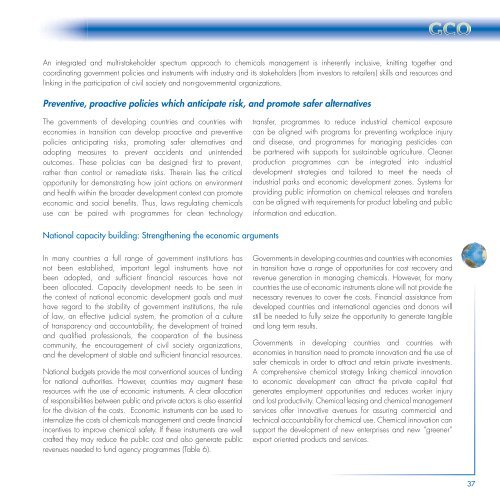Global Chemicals Outlook - UNEP
Global Chemicals Outlook - UNEP
Global Chemicals Outlook - UNEP
You also want an ePaper? Increase the reach of your titles
YUMPU automatically turns print PDFs into web optimized ePapers that Google loves.
An integrated and multi-stakeholder spectrum approach to chemicals management is inherently inclusive, knitting together and<br />
coordinating government policies and instruments with industry and its stakeholders (from investors to retailers) skills and resources and<br />
linking in the participation of civil society and non-governmental organizations.<br />
Preventive, proactive policies which anticipate risk, and promote safer alternatives<br />
The governments of developing countries and countries with<br />
economies in transition can develop proactive and preventive<br />
policies anticipating risks, promoting safer alternatives and<br />
adopting measures to prevent accidents and unintended<br />
outcomes. These policies can be designed fi rst to prevent,<br />
rather than control or remediate risks. Therein lies the critical<br />
opportunity for demonstrating how joint actions on environment<br />
and health within the broader development context can promote<br />
economic and social benefi ts. Thus, laws regulating chemicals<br />
use can be paired with programmes for clean technology<br />
National capacity building: Strengthening the economic arguments<br />
In many countries a full range of government institutions has<br />
not been established, important legal instruments have not<br />
been adopted, and suffi cient fi nancial resources have not<br />
been allocated. Capacity development needs to be seen in<br />
the context of national economic development goals and must<br />
have regard to the stability of government institutions, the rule<br />
of law, an effective judicial system, the promotion of a culture<br />
of transparency and accountability, the development of trained<br />
and qualifi ed professionals, the cooperation of the business<br />
community, the encouragement of civil society organizations,<br />
and the development of stable and suffi cient fi nancial resources.<br />
National budgets provide the most conventional sources of funding<br />
for national authorities. However, countries may augment these<br />
resources with the use of economic instruments. A clear allocation<br />
of responsibilities between public and private actors is also essential<br />
for the division of the costs. Economic instruments can be used to<br />
internalize the costs of chemicals management and create fi nancial<br />
incentives to improve chemical safety. If these instruments are well<br />
crafted they may reduce the public cost and also generate public<br />
revenues needed to fund agency programmes (Table 6).<br />
transfer, programmes to reduce industrial chemical exposure<br />
can be aligned with programs for preventing workplace injury<br />
and disease, and programmes for managing pesticides can<br />
be partnered with supports for sustainable agriculture. Cleaner<br />
production programmes can be integrated into industrial<br />
development strategies and tailored to meet the needs of<br />
industrial parks and economic development zones. Systems for<br />
providing public information on chemical releases and transfers<br />
can be aligned with requirements for product labeling and public<br />
information and education.<br />
Governments in developing countries and countries with economies<br />
in transition have a range of opportunities for cost recovery and<br />
revenue generation in managing chemicals. However, for many<br />
countries the use of economic instruments alone will not provide the<br />
necessary revenues to cover the costs. Financial assistance from<br />
developed countries and international agencies and donors will<br />
still be needed to fully seize the opportunity to generate tangible<br />
and long term results.<br />
Governments in developing countries and countries with<br />
economies in transition need to promote innovation and the use of<br />
safer chemicals in order to attract and retain private investments.<br />
A comprehensive chemical strategy linking chemical innovation<br />
to economic development can attract the private capital that<br />
generates employment opportunities and reduces worker injury<br />
and lost productivity. Chemical leasing and chemical management<br />
services offer innovative avenues for assuring commercial and<br />
technical accountability for chemical use. Chemical innovation can<br />
support the development of new enterprises and new “greener”<br />
export oriented products and services.<br />
37

















